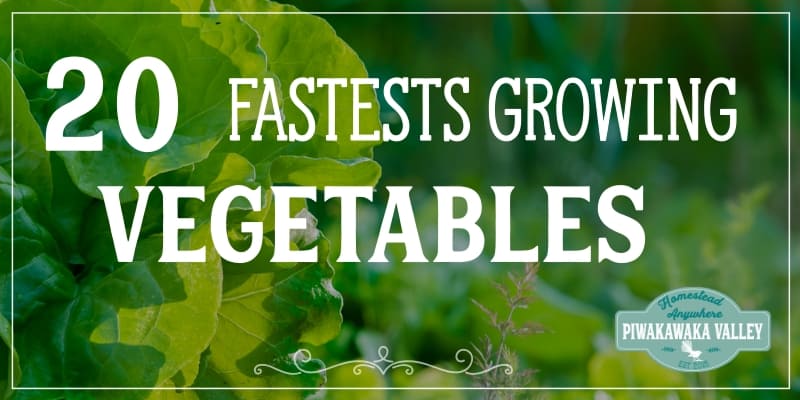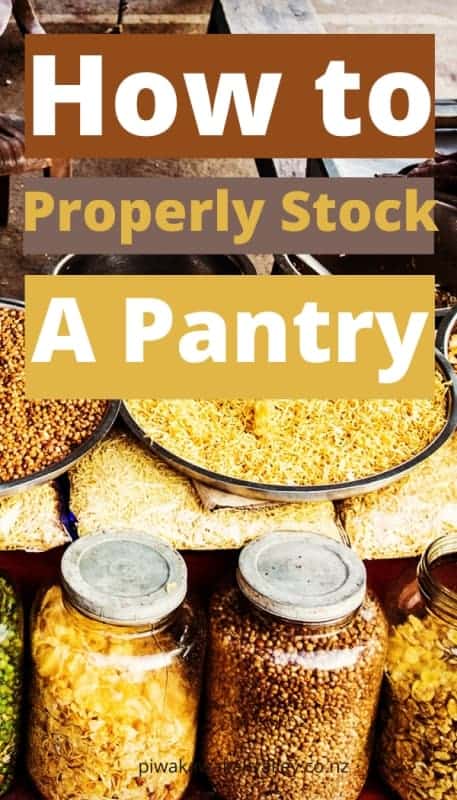This post was most recently updated on March 7th, 2022
Learning how to properly stock a homestead pantry takes some practice, but it is worth learning how to do it right.
There are many people today that have decided to start homesteading, us included. Homesteading is also known as self-sufficiency or self reliance and a large part of that is good food storage systems.
Please read: This information is provided for educational purposes only and is not intended to treat, diagnose or prevent any disease. We encourage you to make your own health care decisions in partnership with a qualified health care professional.
This post contains affiliate links, this means at no extra cost to you, we make a commission from sales. Please read our Disclosure Statement
Homesteading involves growing and harvesting your own food, and storing the food that you produce, usually in a pantry or cool store.
For year-round food security it is really important that you properly stock your homestead pantry.
A well stocked homestead pantry will allow your entire family to always have plenty of food to eat, no matter what the season, or other goings on in the world.
There are certain strategies that you must use to have a fully stocked homestead pantry that will not only save money, but will also provide food security throughout the year, while also preserving the food so that it remains safe and palatable to eat.
Long term storage of canned food as well as staple dry goods will mean that you can space out your grocery shopping, or even skip shopping all together for a while. A well stocked pantry combined with a functioning garden full of veggies becomes your very own food bank to draw from whenever you need to.
RELATED: 11 unique ways to save money on your groceries
RELATED: 10 plants you can grow for flour
What Is In A Homestead Pantry?
Most people today have a pantry of some sort at home. It is commonly stocked with food that they will purchase at the local grocery store.
Although many people will use their pantry for small amounts of food that will last several days, homesteaders must have enough to exist for weeks if not longer in case of a road washout or some other reason that makes getting to town difficult.
The items that you produce and store in the pantry will allow you to prepare food on a daily basis for months.
You will probably also have items that are stored in jars, allowing them to last for many months or years on your pantry shelf.
Many homestead pantries will include items for baking including sugar, flour, chocolate chips and cornmeal.
They will have dried goods that they produce on their property including dried beans, fruits, and even raisins.
Rice and beans are quite common, along with canned tomatoes, plus they will have an assortment of dried pasta and herbs. As well as other flavouring items like garlic powder, soy sauce, olive oil, peanut butter and tomato paste to make tasty and nutritious meals.
All of these items will be used in the preparation of meals, but the pantry must be properly stocked to provide optimal food security.
Usually these bulk foods are stored in large bins or barrels in the basement, kept cool, dry and dark as well as protected from mice and insects.
You will need to learn how to cook from your pantry. There are many quick and easy dinners that you can throw together, I suggest you get a recipe book to cook from scratch.
RELATED: best vegetables to grow in pots
There is no point in storing food if you don’t like it, don’t know how to cook with it, or don’t rotate it through so it doesn’t spoil.
RELATED: How to pressure can vegetables and meat for beginners
How To Create A Food Pantry List
There are several steps that you need to take in order to create a fully functional food pantry list.
This will include starting with the attitude that you always need to be prepared for your access to a local store to be cut off.
Whether you are producing most of your own food, or if you are purchasing some of the products that you need in bulk at a local store, you need to know what you have and what you need at all times.
You also need to organize all of the food in your pantry so you can keep track of what you have in stock.
This will allow you to fill the gaps of what needs to be replenished more easily.
Finally, you also need to have a list of the meals that people would like to make. Everyone will have their favorite types of food for breakfast, lunch and dinner.
This list will also need to include drinks that you will want to stock up on.
What foods do you eat?
By understanding what people in your house want to eat, you can purchase the base supplies for creating these meals, and also plan ahead of time if you are planting and growing this food on your own.
One final list that you may want to make includes those items which are outside of the pantry itself. This will include pet food if you have dogs and cats, feminine items, toilet paper, diapers, and soap and shampoo.
Many of these items can be bought in bulk on special and stored for a very long time.
By being fully aware of the supplies that you need, and understanding what needs topped up, you will always have enough supplies to get through.
RELATED: How to make onion powder
How to stock a pantry for the first time
If you are stocking your pantry for the first time, it can be a very expensive exercise. It is best to make your pantry list, and then start by buying the very basics that you will need for the next week or two.
Then every time you do your groceries, add in another item from the list as well. This will only cost you another $5-10 on top of your usual grocery bill, but will add to your pantry stores.
I would start with a single shopping trip and buy flour, salt, sugar, pasta, rice, your favourite herbs and spices, tea, coffee and anything you don’t think you can get through a week without.
Then each time you buy a new item, buy enough to last you at least a month with that item, if you buy in bulk most of these pantry staples are inexpensive and store well.
If you need to start your pantry from scratch, you may also need to invest in some storage containers. Personally we use clip top jars like these. I like them because they are large, air tight and easy to see how much I have left on the pantry shelf.
Items every homestead pantry should have
Dried goods
Flour
Sugar
Lentils
Beans
Rice
Dried herbs
Dried vegetables
Spices
Salt
Baking powder
Cocoa
Brown sugar
Icing sugar
Mustard powder
Oats/oatmeal
Shredded coconut
Other alternative flours that you use in your family
Nuts/seeds that you like to eat
Raisins
Dried fruit
Milk powder
Tea/coffee
Pasta
Dried mushrooms
Soup mix
Canned goods
Soup
Stock
Fruit
Fish
Sauces
Tomatoes
Pickles
Beetroot
Coconut milk/cream
Sweetened condensed milk
Surplus vegetables from the garden
Bottled goods
Oil
Vinegar
Chili sauce
Soy sauce
Tomato passata or tomato paste
Frozen goods
Meat
Fish
Surplus vegetables from the garden
Butter
Milk
Cheese
Others
Toilet paper
Cleaning products
Feminine hygiene – I prefer my cup
Deodorant – I make our own
Toothpaste – we make tooth powder
Canning lids and jars
Soap – make you own
Dish detergent
Laundry powder – make your own
Dog/cat/chicken food
If you are looking to have enough food in your pantry to support your family for any length of time, be sure to stock up on these pantry essentials from this list. Write the date on the top of the food and use the oldest stock first.
How to Stock A Homestead Pantry on a Budget
Stocking a pantry can be a very expensive exercise. I like to treat my pantry like a savings account. By saving a little each week it means when I’m on a tight budget or nasty bills occur, I will be able to cut my shopping bill in half and use what I already have stocked away.
If you think of your pantry at being in layers. Each week, you invest 5 to 10 dollars a week in either of these layers. It can take a good 6 months to build a solid pantry that you can fall back on. So take a look at what you have already and build on from there what you need.
Top layer
These are the basics for many meals.
- Potatoes
- Rice
- Flour
- Oats/oatmeal
- Pasta
Second layer
These are things that go with anything, and add the flavours to meals.
- Dried Beans
- Lentils
- Tinned Tomatoes
- Oils/fats
- Vinegar
- Sugar
Third layer
The third layer is things that cost around a dollar that you eat weekly for easy quick meals.
- Pasta mixes
- Baked beans and Spaghetti
- Tinned fish
- Cans of soup
- Creamed corn
- Pot noodles/instant noodles
Avoid packaged snack foods as much as possible. Try to learn to make these from scratch instead.
Keep it as clean as possible and you’ll have the best chance to save money. Fruit, vegetables, meat, grains, eggs, pantry essentials.
RELATED: Dehydrating vegetables without a dehydrator
Shopping on a budget while stocking your pantry
Start with the first layer. Spending 5 to 10 dollars on each item each week. Some weeks it will work to buy two or three small things depending on what’s on special, other weeks it will benefit you to buy one bigger item.
For example if you buy oatmeal/rolled oats, but buy two bags so you have about 3 kilo/6lb for 5 dollars. These will last a long time and even if you are not a big oatmeal/porridge fan there’s so much you can do with them.
We don’t need to use them all the time, but it is a really good survival food to have in your pantry when you need it.
You can also soak them overnight. Blend them up. Strain them to make Oat milk if you are all out of dairy.
RELATED: Making dairy free milk
Beans and lentils I love having both dried and tinned. Tins you tend to use first as they are so convenient.
Then dried is just always good to have on hand, soak them over night and boil them for about an hour, pour off the water and boil for another 20 minutes.
We will use these the most to bulk up the meals if we are short on meat protein. The cost of these per kilo is so low it’s so worth having on hand
You can mash them up with some kumara, or potatoes, add a little flour, spices, egg or water to bind them up and then fry them up. Easy burgers.
If you are someone who enjoys baking it is worth it to spend the money on a big bag of flour. If you are not really that person it’s probably best to spend a few dollars at a time and just buy a small bag when you see it on special.
Focus on what you enjoy to cook first. Then increase your skills as you have time and confidence to do so.
Tips for shopping on a budget
Don’t buy an item if it’s not on special. Wait for it to be on sale and choose another item on the list for this week.
This is why I feel it can be good to shop around, different stores have different specials each week. If you can gather coupons and use them!
Keep and eye out for clearance items too, short dated stock will usually freeze until you are ready to eat them.
Avoid the specials stands at front of the supermarket and go straight to pick up these items where you normally find them so you can compare the on special item to the off brand products to get the best deals.
Think constantly “do I need this” – if it’s packaged processed food you probably don’t.
Get to know your supermarkets habits so you don’t get ripped off. Many items rotate which brand is on special, laundry detergent and nappies/diapers are common ones for this to happen. Be flexible in the brands that you buy.
Eat with the seasons. Eat what’s on special. Tomatoes, avocados, cucumbers only in summer. Pumpkin, cabbage and cauli in winter.
For the best resource on growing your own food and eating seasonally, check out our book
How to stock a pantry for an emergency
If you follow the buying plan above, you will be able to slowly build a usable pantry that will serve you well in an emergency. The last thing you want to do in an emergency is to start trying to stock your pantry, this does nothing but cause more panic buying.
Work out what you need each week and double it. This means that at the end of a month, you will have a whole extra month worth of food set aside.
Be sure to rotate the stock and use your oldest food first.
Don’t binge buy things that you don’t actually use or know how to cook. Filling your cupboards with dehydrated vegetables isn’t helpful if you have no intention on eating them before they go off!
How to stock a pantry for a year
If you really want to be prepared for whatever may happen, the prepper would like to have a year’s worth of food ready to use and stored away.
To store a years worth of pantry food you will need a large storage area, most people use their basement. You will need big mouse-proof bins to keep your staples in and you are better off buying one to two items from the pantry stocking list per month, but buy them from a food supply store and try and buy the biggest sack of that item you can buy.
When you are creating your pantry list, work out how much of a food you use in a two week period and multiply it by 26 to get a years worth.
What to do if you have to live out of your pantry
No matter who you are or where you live, there will be times where having a well stocked pantry will serve you well. Learning to live eating out of your pantry is a great way to make sure you are used to using the staples, and that none of the food goes to waste.
Creating your own comfort food will help you avoid spending money on expensive convenience meals. Get the food you enjoy and satisfies you. Make a hearty stew, mac n cheese, homemade bread, you can even get frying oil that you can reuse and deep fry your own food.
Now is the best time to get into cooking. Get on the internet and youtube and search for your favorite recipes. Here is a great selection of easy last minute meals.







